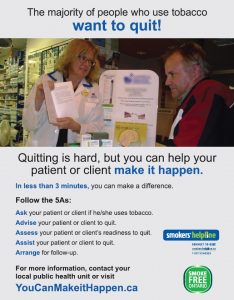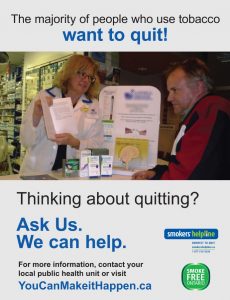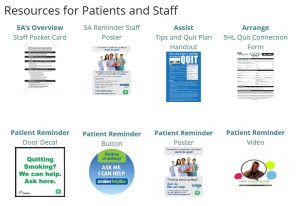PHARMACY
Impact of interventions on tobacco use morbidity and mortality
A local pharmacy provides a convenient location to access a health professional who can assist with smoking cessation. The community pharmacist is familiar with the drug therapy needs of their patients and they provide information to the public on all areas of wellness and chronic disease management.
Pharmacists support patients who want to quit smoking by adding to the choice of options for counselling, by providing quit smoking materials and by improving access to smoking cessation medications. In 2012/2013, a total of 31,958 Ontario Drug Benefit Program patients received smoking cessation medication – such as Zyban ™ and Champix ™ or counselling at a community pharmacy, the highest reach of any Ministry of Health and Long-term Care funded program.
Evidence to support tobacco dependence interventions
There are multiple competing priorities facing Ontario pharmacies. In order to gain leadership/ownership support for the integration of tobacco dependence interventions into pharmacy practices it is important to incorporate evidence into your planning tools and discussions with decision makers.
- Community pharmacy personnel interventions for smoking cessation – Article
- Tobacco Interventions Delivered by Pharmacists: A Summary and Systematic Review – Abstract
- Ask your pharmacist video – Ontario Pharmacists Association
- The role of the pharmacist in a Family Health Team setting – Ontario Pharmacists Association
Examples of evidence-based practice systems
There are evidence-based program examples and tools which already exist to help you move your project forward. These programs include a variety of frameworks, models, templates, tools, billing information and resources to help you plan, implement and evaluate your program.
Contact the programs directly for more information or resources.
Residents of Ontario who are taking a minimum of three medications for a chronic condition can meet with a pharmacist one-on-one for a 30 minute annual appointment to:
- Review medications and help the patient better understand their medication therapy
- Ensure that medications are taken as prescribed.
- There is no cost to the patient. For eligible patients may contact their pharmacists if they require another MedsCheck during the year for reasons including a planned hospital admission or managing their medications after being discharged from the hospital.
The MedsCheck program includes questions which assess patient tobacco use.
Pharmacy Smoking Cessation Program – Ontario Ministry of Health and Long-term Care (MOHLTC)
Community pharmacists are funded by the Ontario Government to provide smoking cessation for Ontario Drug Benefit (ODB) recipients (Sept 2011).
- Aligns with other smoking cessation programs in primary health care and community settings to provide smokers with a continuum of care.
- Communicate to the public the value of smoking cessation services by community pharmacists and promotion of availability of services
- Improves access to and choice of stop smoking services, including advice on smoking cessation options, support tools, resources and follow-up.
- Provides patients with a consistent, evidence-based standard of care based on a screening mechanism, cessation counselling, structured documentation and support.
Community pharmacists can provide one-on-one support and advice to ODB recipients who want to quit smoking. The following services are available:
- Readiness assessment where a patient may enrol in the smoking cessation program with the pharmacy
- First consultation
- Follow-up counselling sessions over a one-year period. The pharmacist can recommend and prescribe appropriate stop smoking drugs and aids and dispense either Champix or Zyban to ODB recipients.
Examples of assessment and pharmacotherapy tools
- Free stop smoking medications are available in Ontario.
- Pharmacy Smoking Cessation Program – Ontario Ministry of Health and Long-term Care (MOHLTC)
Community pharmacists are funded by the Ontario Government to provide smoking cessation for Ontario Drug Benefit (ODB) recipients.The MOHLTC have provided patient assessment and pharmacotherapy tools to assist you in implementing and receiving payment for the Pharmacy Smoking Cessation Program. The documentation tools include:- Readiness assessment, patient consent form, first consultation meeting, quit plan, primary follow-up sessions 1-3, secondary follow-up sessions 4-7 and the program evaluation.
- The MOHLTC have provided a fact sheet which provides an overview of the program
- Canadian Pharmacists Association (CPhA)
Patient documentation form for the Ontario Government’s funded QUIT Smoking Program. The CPhA has created an interactive documentation format which incorporates and expands on the MOHLTC’s standardized documentation templates which are required to meet the standards of care and to maintain program consistency. The form can be completed manually or electronically. The document supplements the CPhA’s evidence based, comprehensive continuing education CCCEP-accredited online QUIT (Quit Using and Inhaling Tobacco) training program. - Ontario Pharmacists Association (OPA) – Member Login for Smoking Cessation Continuing Education Certificate and Toolkit
In order to be eligible to receive funding for provision of the Ministry of Health and Long-Term Care’s (MOHLTC) pharmacy-based smoking cessation program for Ontario Drug Benefit recipients pharmacists are required to complete a smoking cessation training program.The training will provide you with valuable information on the rationale for doing tobacco cessation in the pharmacy setting; how to set up a smoking cessation program in your pharmacy including how to use the documentation/patient assessment tools; and how to implement the program in your pharmacy including patient screening, enrollment, appointments and pharmacotherapy tips. You will receive as a part of this training a toolkit which includes helpful patient assessment and pharmacotherapy tools. - A Model for the Busy Pharmacist (CATALYST) – Call to Action on Tobacco Addiction
The CATALYST continuing education program manual includes a tools section with various patient assessment and pharmacotherapy tools matched to the 5 As model for tobacco cessation (ask, advise, assess, assist, arrange). Examples of tools include:- Algorithm and 5 minute guide to using the 5 As of tobacco cessation
- Fagerstrom test for nicotine dependency, Smokeless tobacco dependence scale, various tobacco use questionnaires based on patient readiness to quit
- Tools to increase motivation to quit with smokers not ready to quit
- Patient workbooks
- A medication overview table, series of frequently asked question documents on bupropion, NRT and varenicline, drug interactions table, referral and MD notification letter templates
- Checklists and additional resource lists
- Marketing tools for your pharmacy such as a brochure, bag stuffer, shelf talker and a personal selling example video script
For more information or to register for the CATALYST program go to http://www.cccep.ca/show_prov_program.php?provider_prog_id=717
- The Centre for Addiction and Mental Health – Addictions Toolkit – Smoking Cessation
This toolkit provides practical information on screening, assessing and managing patients who are trying to quit smoking. It includes patient assessment tools, information on pharmacotherapies (NRT and prescription meds), links to other professional resources, including best practice guides and patient information materials and self-help resources.
Resources for staff and clients
Resources Tailored for Pharmacy Patients and Staff:
| 5A Reminder Staff Poster  |
Patient Reminder Poster  |
Additional Resources for all health care settings  |
Available for download. Contact your local Public Health Unit or Smokers’ Helpline for requests to adapt resources.
Training opportunities for pharmacy staff
Pharmacists are considered a credible source of information by patients – you can help your patients to quit smoking, even with just a few minutes of your time.
Training opportunities for Brief Contact Intervention with clients, as well more intensive interventions are available.
Canadian Council on Continuing Education in Pharmacy (CCCEP)
- Accredited smoking cessation training programs listed in the continuing education program database
Smoking Cessation Online Learning Module – Ontario Pharmacists Association (OPA)
- Recognized as a MOHLTC approved program. This program is assigned 2.0 CEUs. Participants will be awarded CEUs based on the total number of program contact hours attended. CCCEP Accreditation File No: 8003-2014-1007-I-P. Accreditation Period: March 14, 2014 to March 14, 2015
- Provides an overview of concepts and best-practice approaches currently used in the management of smoking cessation by healthcare professionals.
- A pharmacist toolkit is available in the member section of OPA’s website.
A Model for the Busy Pharmacist (CATALYST) – Call to Action on Tobacco Addiction
- The Canadian Council on Continuing Education in Pharmacy has accredited this program for up to 6 CEUs (CCCEP File #1044-2011-221-L-P).
- Self-learning and workshop format to:
- Help community pharmacists implement a systematic approach to smoking cessation in their practice
- Provide community pharmacists with practical tools to effectively screen for tobacco use, treat and counsel smokers, and follow-up with appropriate smoking cessation interventions
- Guide community pharmacists on how to develop and promote a smoking cessation service
- Accredited by the Ontario College of Pharmacists for 40.5 credits.
- Knowledge translation project offering Canada’s only internationally-accredited certificate program in cessation counselling (Herie et al., 2011; ATTUD).
- 5 hour certificate program (online (7.5 hours) and classroom (5 days) provides intensive tobacco cessation counselling
- In order to complete the TEACH Certificate Program, students must complete the online, pre-requisite OTRU course, the three-day core course, one specialty course, and all pre- and post-learning assessments.
